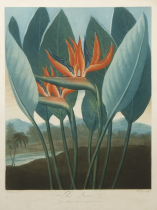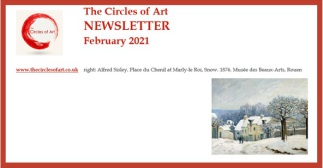|
‘Dr Thornton’s Temple of Flora’ is considered by many to be the greatest of all flower books.
Dr Robert John Thornton (b.1763) went to Trinity College, Cambridge, initially to study
for the Church. After attending lectures on botany and the work of Carl Linnaeus, the Swedish botanist who had developed the first system for classifying and naming organisms, he switched to
medicine, and on graduating worked as a doctor and lectured on medical botany at St Thomas’s and Guys Hospitals in London.
He published several minor works before, having inherited a family fortune, he embarked on
his major publication, The New Illustration of the Sexual System of Carolus von Linnaeus – a work of botanical science to be published in three parts. First advertised in 1797,
part one was a dissertation on the sex of plants according to Linnaeus, the second an exposition on the sexual system. In the most ambitious, part three, he intended the work to be a book “which in
point of Magnificence is intended to exceed all other Works of a similar Nature on the Continent”.
Thornton was an ardent royalist and imperialist and felt that this volume should
demonstrate England’s pre-eminence in the field of botanical illustration. Originally intended to contain 70 colour plates, each based on original paintings commissioned from “all the most eminent
English artists”, he considered it a national undertaking, dedicating it to Queen Charlotte, wife of George III. One of the more curious plates shows Cupid aiming an arrow at a flowering strelitzia,
entitled “Cupid inspiring the Plants with Love”. Strelitzia reginae or the bird of paradise plant, was introduced from Africa by Sir Joseph Banks, who named it in honour of the
Queen, daughter of the Duke of Mecklenberg-Strelitz in 1773.
My own copy of ‘The Queen’, as with other plates, is a mixed method engraving of amazing
quality, including mezzotint, aquatint, stipple and line engraving, printed in colours and finished in watercolour by hand. Engraved by Robert Cooper after the original painting by Peter Henderson,
it is a magnificent and luxurious undertaking, and, an immensely expensive one. Every colour must be inked individually by hand separately for each plate, and then finished in watercolour. To
complete each plate must have taken hours. As published, it was accompanied by a flowing text and a poem by the Poet Laureate.
Subscriptions were taken up by the King and Queen and many members of the scientific
intelligentsia, but the numbers of supporters were never sufficient for the project to succeed, nor indeed to complete it. Despite opening a gallery in London in 1807 to sell the original works and
promote sales, and later getting permission for a lottery, the expenses of the project were too great. The third volume was published as a ‘whole work’ in 1807, including all 31 plates to date,
despite containing less than half of what had been originally planned. Thornton was nearly destitute and returned to medicine and smaller literary works, dying impoverished in
1837.
Mary Axon, member of The Circles of Art
|



